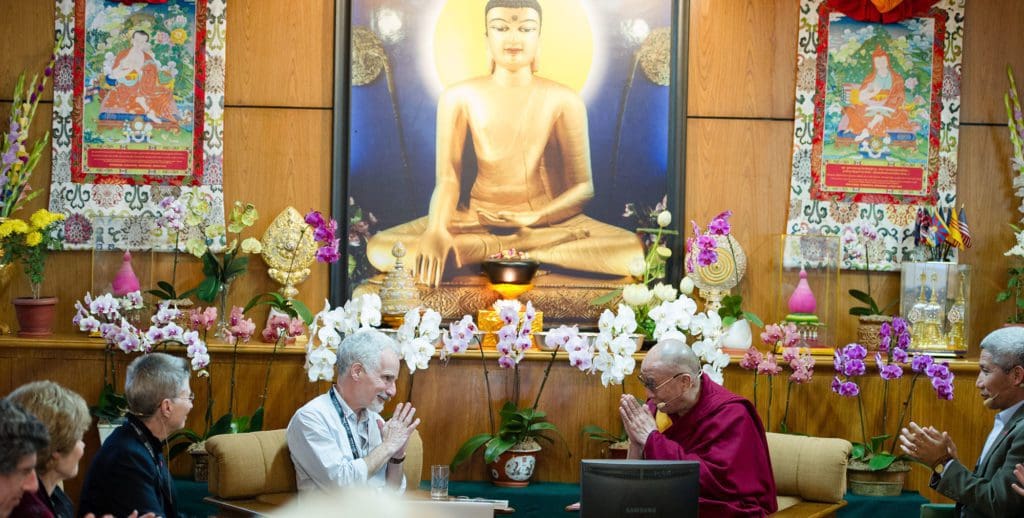Filmed during Mind & Life Institute’s “Mind & Life XXVII: Craving, Desire and Addiction” on October 29, 2013.
Day Two: Cognitive and Buddhist Theory
Cognitive neuroscientist Kent Berridge begins the day with an exploration of the neural circuitry underlying the experience of wanting, and a description of how this can be studied scientifically. He then contrasts both the brain pathways and the subjective experience of wanting with those of the hedonic experience of pleasure, or liking. Addiction can be viewed as an extreme sensitization of the wanting system that can become decoupled from the experience of pleasure. Thupten Jinpa then explores Buddhist philosophy around craving and grasping, highlighting links to both scientific conceptualizations as well as the direct experience that is so central in addiction. He also addresses how these views might have implications for treatment.
Brain Generators of Intense Wanting and Liking
SPEAKER: Kent Berridge
Brain mechanisms for intensely “wanting” something are different from the mechanisms for “liking” that same thing. “Wanting” generators, robust and large mechanisms that include many brain structures, are easily stimulated into highly reactive states. In stimulated brain states, encountering cues related to the temptation (or vividly imagining it) triggers intense pulses of craving. In addicts, the brain “wanting” generators may become further stimulated through neural sensitization by drugs (or by natural causes). Sensitization can produce intense wanting even for something that is not “liked.” By contrast, brain “liking” mechanisms that generate intense pleasures are smaller, fewer, fragile, and easily disrupted. This is one reason why intense pleasures are far less frequent or lasting than intense desires. The independence of brain “wanting” mechanisms allows causation of intense desires that can become quite irrational. An interesting feature of “wanting” mechanisms is that they can generate intense desire even for things that cannot be expected to be pleasant or things that have always been unpleasant in the past. This capacity to “want” what is known to be unpleasant evolved for adaptive natural appetites, but it has been co-opted by maladaptive addictive drugs. Finally, there is surprising overlap in the brain between mechanisms that generate intense mesolimbic “wants” and mechanisms that generate some types of fear. That is, the same brain circuit can have different modes that generate desire and dread, and can even produce both emotions at the same moment.
Psychology of Desire, Craving, and Action: A Buddhist Perspective
SPEAKER: Thupten Jinpa
The early Buddhist sutras-scriptures attributed to the Buddha-speak of how attachment or craving constitute a primary source of our suffering, and how true freedom from suffering emerges through letting go of attachment or craving. Underlying these statements is an important psychological insight that draws an intimate connection between our perceptions of the world and the experience they give rise to on the one hand, and the arising of craving and how this leads us to act in a particular way on the other. This understanding is characteristically formulated in the early texts as the following: “Conditioned by contact there is feeling (experience); conditioned by feeling there is craving; conditioned by craving there is grasping; conditioned by grasping there is becoming.” In this presentation, Jinpa briefly outlines a standard Buddhist account of the causal and dynamic interconnections between the key elements that are part of the psychology of craving as formulated in the above quotation, namely: contact, experience, craving, grasping, and action. From the Buddhist psychology point of view, Jinpa argues how desire, craving, and addiction may be understood in terms of a spectrum rather than as categorically distinct states. Finally, Jinpa identifies specific insights we might draw from this classical Buddhist understanding of the psychology of craving and bring them to bear upon two topics: our current scientific understanding of the pathology of addiction, and the possible development of non-pharmaceutical interventions for its treatment.
INTERPRETER: Thupten Jinpa
PANELISTS:
His Holiness the 14th Dalai Lama
Sarah Bowen
Richard J. Davidson
Wendy Farley
Vibeke Asmussen Frank
Roshi Joan Halifax
Marc Lewis
Matthieu Ricard
Nora Volkow
Diana Chapman Walsh
Arthur Zajonc
Participants

Kent Berridge
University of Michigan



